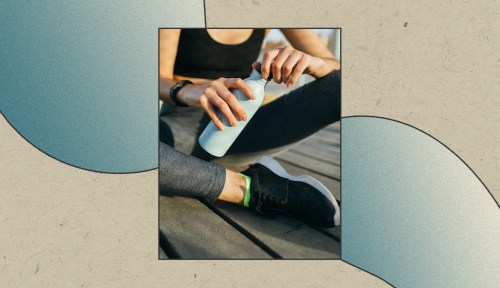For runners, there’s nothing more invigorating than lacing up your sneakers and heading outside to enjoy pounding the pavement with the great outdoors as your backdrop. But while you’re taking in the epic scenery, there’s something important to consider: Are your running shoes impacting the environment you love so much?
As a whole, the footwear industry is responsible for 1.4 percent of global greenhouse gas emissions. Then there’s the sneaker segment, which—if it was a country—would be the 17th largest polluter in the world. When you look at the impact of running shoes, it’s easy to see why: Researchers at MIT found a single pair of running shoes generates 30 pounds of carbon dioxide emissions—the equivalent of keeping a 100-watt lightbulb on for one week.
Two-thirds of a running shoe’s carbon impact can be attributed to manufacturing, followed by a smaller percentage from acquiring or extracting raw materials. The reason the manufacturing is so unsustainable is namely due to the manufacturing plants, which rely on coal as their prime source of electricity. Running shoes also have numerous tiny parts—65, to be exact—that take 360 steps to assemble, most of which are non-biodegradable and carbon-intensive synthetics and plastics.
As a consumer, this reality can make finding a sustainable pair of running shoes tricky. “Running shoes are a tough purchase from a sustainability perspective, because there are multiple technical materials required to maintain performance, which often require fossil-fuel derived synthetics, making them difficult to recycle,” says Alyssa Beltempo, a slow fashion expert and sustainable stylist.
It also doesn’t help that running shoes need to be switched out regularly in order to keep you injury-free and feeling your best, typically every 300 to 500 miles. Beltempo says this cutoff makes it hard to follow the number one rule of sustainable fashion: keeping your clothes for as long as possible. With that being said, there are steps every runner can take to make their running shoe lifecycle more eco-friendly.
Wear: Choose the best (sustainable) option for your feet
According to Beltempo, a shoe that isn’t worn isn’t sustainable in the first place. So the best thing you can do for your feet—and the planet—is take the time to find a pair you know will be in your life for the foreseeable future. “Get the best shoe for your needs from the start to reduce the chance of wasted resources,” she says. Instead of ordering a cute pair online on a whim, that might first mean visiting a local running store that can offer an assessment of your gait to ensure you’re choosing the right pick from the get-go.
Now that you have information on which features you should be looking for in your perfect running shoe, see if you can find a more sustainable sneaker that checks off your boxes. Beltempo says everyone’s running and fitness needs are going to be different, so it’s hard to specify which materials are best. “But looking for recycled synthetics (think recycled polyester) or renewable fibers (corn fiber and algae bloom, for example) is a great way to incorporate a gentler environmental footprint without sacrificing performance,” she says.
These eco-friendlier materials are becoming increasingly common as more consumers prioritize sustainability in their workout routines. That includes both sustainable sneaker brands like Allbirds, Veja, and Lane Eight, as well as big-name brands you can find just about anywhere that are making strides on the sustainability front. Adidas, for example, is utilizing recycled ocean plastics in its sneakers, and On Running recently developed the first shoe made from carbon emissions.
Lastly, before making your purchase, look for the brand’s transparency—“particularly around their supply chain information,” Beltempo says. “Are factories audited by a third party? Are garment professionals paid a living wage? These are questions that I start with when researching transparency.” Once you find a match that aligns with your values, hit that “buy now” button.
Reuse: Make your running shoes last as long as possible
Once you have a new pair of running shoes gracing your feet, the next step in making its lifecycle more eco-friendly is extending its life as long as possible. Taking proper care of your sneakers not only benefits the planet—it also saves you money. Because as we all know, these shoes aren’t cheap.
First, resist the urge to wear your running shoes outside of your workouts. Yes, they look great with your leggings on grocery runs, but you’re adding unnecessary mileage, which means you’ll need to replace them sooner. Also ensure you’re treating them well not just while you’re wearing them (try to skip the mud and puddles!), but also when you’re not.
“A few things that maintain the life of your sneakers are to not dry them near a heat source—just let them air-dry in the sun,” Beltempo says. “Also wash them with a cloth and warm water, or check laundry instructions if they’re able to go in the washing machine.”
Here’s another pro tip: Keep track of when you bought your running shoes and how long they last. Your detective work might uncover something that helps with future purchases, like one brand lasting considerably longer than another before falling apart.
Recycle: Get rid of your worn-out running shoes, sustainably
All sneakers are going to break down eventually. With the right tools up your sleeve, you can ensure disposing them doesn’t negatively impact the environment. Since running shoes can be difficult to recycle due to the mix of materials each involves—think: rubber, foam, plastic, leather, and glue—first look to the brand you purchased them from.
Many brands now have recycling or take-back programs that keep old shoes out of landfills. On Running, for instance, has a subscription program that sends you a fresh pair when needed and allows you to send back your old shoes, which are then washed, grinded, and transformed into new sneaker components. Then there’s Nike, which allows you to drop off shoes at participating retail stores. They’re then either recycled or cleaned and donated, depending on how worn-out they are.
There are other options, too: You can donate gently-used shoes to Soles4Souls and One World Running, or recycle them through the American Textile Recycling Service. Maybe even transition them from your running shoes to your errand-running-sneaks or gardening shoes. Whatever you do, don’t throw them away. With a little extra care, every running routine can become a little more eco-friendly.
Sign Up for Our Daily Newsletter
Get all the latest in wellness, trends, food, fitness, beauty, and more delivered right to your inbox.
Got it, you've been added to our email list.











